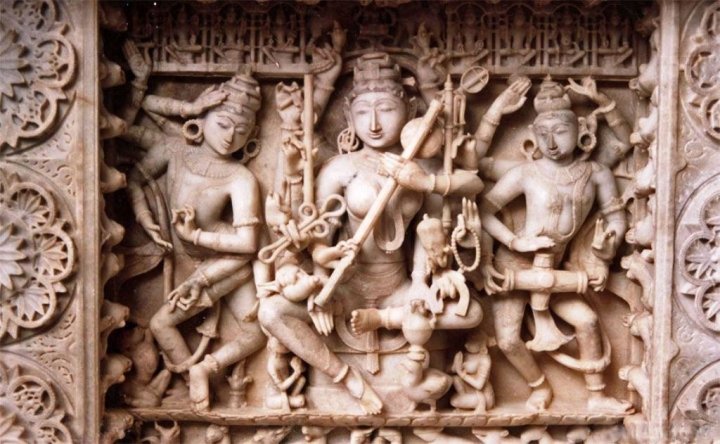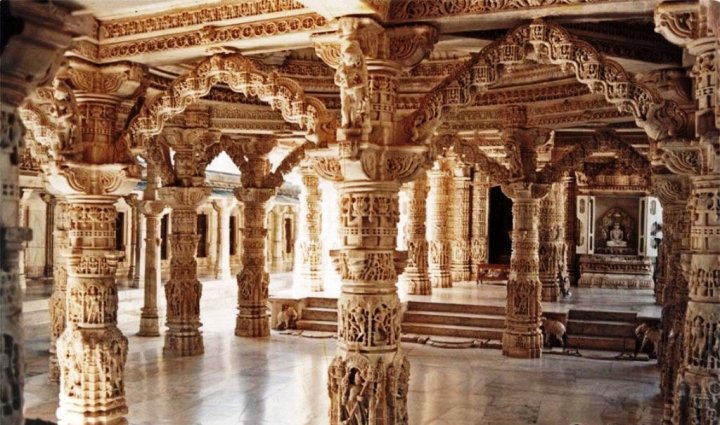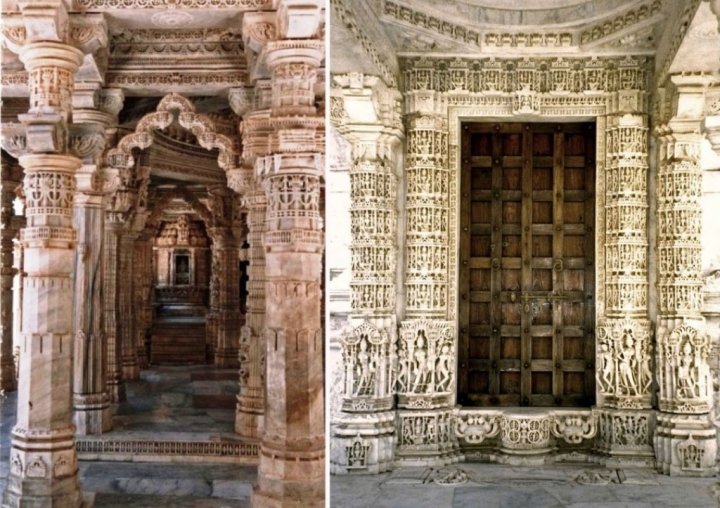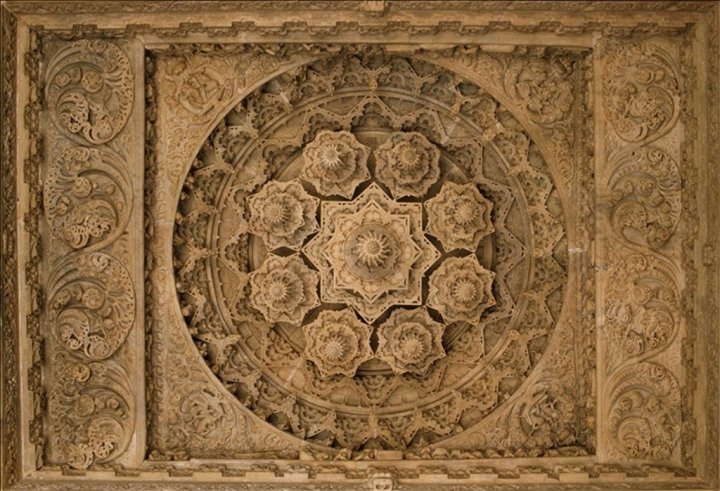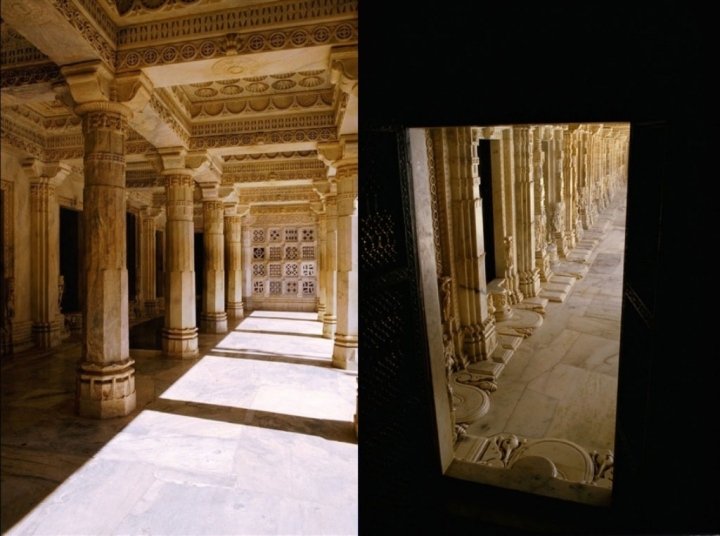After completing the journey of Haldighati, The greatwall ogf India--- Kumbhalgarh Fort and sculpture and architecture wonder Ranakpur jain Temple , we reach Mount Abu in the Night. After taking Hotel , we spent night peacefully with perfect sleep. Next Day plan was to complete the site Seeing there as we had early morning train next day.
Owing to its thick evergreen natural forest region, climate in the Mount Abu has been pleasing and rainfall being the highest in the State with an average of 70 to 180 cm in the monsoon season usually starts at the end of June up until August or September. However, the best season to visit this hill spot is between Mid March to June and September to December.
Summer in Abu normally starts in April lasting up to mid June featuring dry and sunny climate condition, the average temperature remaining around 33.8°C. Those who have been to get away from rainy and winter seasons may visit through this season from February to June, but they would completely miss that flooded waterfalls, lush greenery and amorous mist over at this time.
The best scenic beauty of Mount Abu can be explored usually in monsoon that sets in the mid or end of June with heavy rain and black clouds bringing down the surrounding temperature and the climate seems to be at it fullest. However, rain lovers alone will comfort with this season.
Drive down to Abu in the period between October and March, the season witnessing winter has been indeed a pleasurable trip for honeymoon couplets in which the mercury drops to minus degree C or even lower than this at times. It may perhaps be ideal season to tour the spot that has pristine setting delighted with green lush grass and cool breezing with aroma of beautiful blossoms charming the whole region. But beware of season-packed cottages and homestays and better to have advance booking.
Well-connected with different major cities of India such as Ahmedabad, Delhi, Bundi, Ajmer, Jaipur, and Udaipur by means of roadways, Mount Abu has been 24 km just away from the nearest national highway No. 14. Plenty of private volva and State Transport Corporation buses have been running across to link this popular tourist hill station with various cities in the State and neighboring state, Gujarat and cities of other parts of the country.
To reach this beautiful honeymoon point by trains, Abu road railway station is closer covering 28 km of distance from the main city that has been linked up by railroads to Ahmedabad, Jaipur, Jodhour, Mumbai, New Delhi and so on. There has been state transport service for every hour and taxis/jeeps have been available from Abu Road to Mt. Abu on private and sharing basis as well.
Mount Abu, Rajasthan's only hill station, can be arrived at by means of airways too with the nearest airport being at Udaipur through which direct flight services can be obtained to various parts of India like Ahmedabad, Delhi, Jaipur, Mumbai, etc., covering a distance of 185 km from Mount Abu. However, Ahmedabad connects through daily flights of various air services to those major destinations, which has been about 221 km from Mount Abu.
1.Dilwara Jain Temple - Marble Stone Craft At Its Best!!
Devotional to Goddess Durga (Arbuda), Adhar Devi temple well-known religious tourism spot of the Mt. Abu hill, has been explored in a cave just 3 km away from the Abu town. To land on the temple, tourists have to climb up around 365 steps through the hill region and the deity has been set in a rocky cling and by creeping through a tiny hatchway alone pilgrims can enter into the cave. As it is a temple of Goddess Durga, Navaratri festival season witnesses large gathering of devotees during those nine days. Surrounded by the scenic visuals of exquisite statues, Adhar Devi shrine, finely chiseled out of a solid rock makes climbing the pleasurable chore and the tremendous visual retreat inside makes the flight of 365 stairs worthy indeed.


An awesome structure of Toad-shaped rock overseeing the Nakki Lake is an unimaginable posing that seems as if the toad is set ready to swim into the lake and viewing the city on top of the rock is a novel ambiance attracting the tourers for hours together basking on the rock. Nandi rock, Nun rock and Camel Rock are some of such illustrious structures retreating visual sense.
Though there are numerous tourist attractions in Mount Abu, the Sunset Point holds a special significance rendering breathtaking beauty bonanza. Situated on top of the Aravali hills southwestwardly to Nakki Lake this place makes the tourists to have an inexpressive, enjoyable experience of scenic view of the sun setting. Huge gathering of people swarms this Sunset Point in the evening in the midst of a tranquil atmosphere with the temperature being considerably low offering rejuvenating experience for the vacationers after a tiresome sightseeing travel of the places. This place is structured finely with railings. From the top of the hill the sunset posing seems to be stunning and it is important not to miss watching sunset while taking a trip to Mount Abu. The environment surrounded by beautiful flowers and green trees makes this place attributed for photographic effect.

Setting of sun can be viewed from the Guru Shikhar, the highest peak of Mount Abu as well that impresses the tourers. Other favorite spots are Honeymoon Point and Baylay's Walk that lie closer to the Sunset Point in a distance of just 5 km from Sunset Point with the pony rides making it a thoroughly pleasurable trip for thousands of tourists.
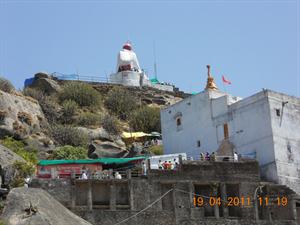
The highest mountain peak of the Aravali hills around 15 km from Mount Abu at an altitude of 1722 meters, Guru Shikar generates an enchanting panoramic view of the Abu town and green Aravali range. To atop the Guru Shikhar peak, the tourists are required to travel about 7 km along the Delwara AchalGarh road and it is a thrilling trek-like experience of course. Guru Shikhar is also a destination for marvelous historic temples. The temple of Guru Dattatreya bags a story in Hinduism that Lord Dattatreya is a deity of the divine trinity of Siva, Vishnu and Brahma and the term 'Datta' means 'given' and Dattatreya is a son of the divine trinity incarnated to a saint couple of Atri and Anasuya. As he is the son of Atri, the name suggests 'Atreya.' Outside of the Shrine is a brass, giant historic bell dated back to AD, which seems as if a sentinel is overlooking the Abu hill. The panoramic view particularly at the dawning from Guru Shikhar Parwat is a tremendous visual fete for adventure tourists.
AchalGarh, also pronounced as Achalgadh, historic monument found in the deserted land of Rajasthan in India is one of the numerous forts that was built by Maharana Kumbha in 15th century. The fort was primitively constructed by the rulers of Paramara Dynasty and renovated later on and named as Achalgarh by Rana Kumbha, who was passionate of designing and built many large forts in the south of Rajasthan. Well connected to the main city of Mt. Abu covering a length of around 8 km, AchalGarh fort enclosed with gigantic fortified battlement walls has been seen at the top of a sloppy, winding pathway providing picturesque view into the countryside. Beautiful Jain temples are also enclosed within the fort.

With the peaceful natural environs, the Brahma Kumari Serene Peace Park is a tranquil treasure for meditation and relaxation and peace lovers will enjoy the serenity and may experience complete powerful effect of meditation in this park. The park situated 8 km from Madhuban, the headquarters of Brahma Kumari Samaj in the Mount Abu is nuzzled in between the famous peaks of Aravali range. Visualizing a brief video clipping that teaches the know-how of Rajyoga the visitors could practice the Rajyoga meditation in a place of their preference, like open place, air grass hut, the stone cave, the bamboo hut or just a peaceful nook of the ambiance. The park also has attractions of recreation retreat consisting of swings, play areas, picnic spots, and walks through nature environs. Uniquely formed rock garden upon the entryway is a home for extensive categories of succulents and an orchard space displays exotic flora, including ornamental shrubs. The surrounding walls enclosing the eight-acre park are ornamented with rose creepers, oleanders and night queens for redolence and bougainvillea to add lifelike colors.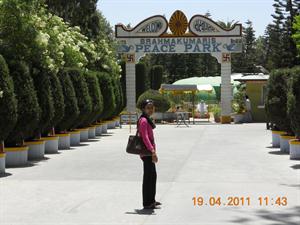
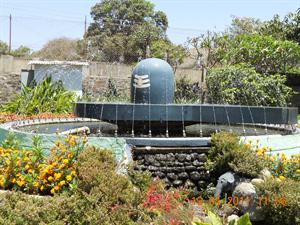
Shantivan, the Brahma Kumari meditation center located on the left side of the Abu Road is a place of picturesque framing. A spacious hall accommodating around 20,000 people known to be Diamond Hall is a zest for wonderful architecture and marvelous piece of art. Another important tourist attraction is Madhuban, international religious community of Brahma Kumari and Madhuban is the headquarters of the Brahma Kumaris World Spiritual University or globally known as Prajapita BrahmaKumaris Ishwariya Vishwa Vidyalaya, which is located near the Nakki Lake.
Domiciliated within the campus of Raj Bhawan, the government museum and art gallery in Mount Abu that was constituted in the year 1962 takes the pride of preserving the archeological monuments of the hill region. Categorized into two sections, first section of the museum comprises of panoramic illustration of local tribal hut with the lifestyle of the tribes including a art gallery of arms and artilleries, musical instruments, furniture, handicrafts, ornaments such as barly, damani, karna, guthma toda, gaga wala thoomar, kanksi berla, different kinds of earrings and costumes, etc. The second section consists of a collection of theme-based paintings on raga-ragnis, lain images from Sirohi, midsize shields, canon called 'Topdi' and pieces of wood carvings. A noteworthy piece of monument amidst the collections of the art gallery is exquisite carving of the statues of Devdasi (Nartaki or dancer) from 6-12th century A.D. that were obtained from the ancient Chandravati town situated 7 kms away from Abu. The image of the Chakrabahu Shiva seated on Nandi, Lord Shiva's bull, holding a trishul and khadag in the hands and dancing girls on both sides of Shiva is indeed marvelous. Around 404 sculptures of Abu collections are also added to the museum, out of which the most unique display is a 3-feet Vish Kanya (Snake Goddess) exhibited as if it is breast-feeding a snake with well-executed features and naturalistic impressive postures. Other important pieces of exhibition are Surya from 8th century A.D. of Achalgarh, the Shiva of 10th century contributed by Dilwara temple, the Chanvar Vahini and Laxmi of 12th century from Chandravati and the Chanmunda of 8th century A. D.
Set up by an engineer from British, named Trevor, this is a nature lovers' paradise. The artificial tank built by the above named professional known as Trevor's Tank is a home to breed crocodiles of multiple varieties in the natural habitat. For bird watchers also, this is a sanctuary in the thick woods of the Abu hills that houses peacocks, partridges and pigeons with natural environment.
Sanctuary in Mount Abu is an excellent wildlife sanctuary with ravishing landscape that offers great experience for nature lovers to explore the nature completely, consisting of more than 17 nature trails or pathways through the woods as shown on the map. Added to these trails, the jungle region includes view points, grasslands, water bodies, horse safari, and sunrise/sunset points. With the trekking, trekkers may have adventurous tourism of rock climbing, rappling, wildlife viewing, bird watching and study about botanical treasure of Abu, its tribal lifestyle and culture of Lok Rajput as well. With prior permission obtained from the State Department of Forests, the sanctuary has various locations for camping in the jungle. The list of locations in which camping has been permitted is as follows:
1. Trevor's tank Dilwara
2. Gaumukh Hanumanji
3. Arna watch tower
4. Salgaon watch tower
5. Jawai village
6. Agneshwar Ashram
7. Rishikesh Temple
8. Chhipa Beri
9. Kuda- mamaji
10. Vasthanji
11. Utraj village
12. Bhrigu Ashram
Major nature trails of the sanctuary are as mentioned below:
1. Tiger Path
2. Craig's Path
3. Beyley's walk
4. Sunset Point - Sakora
5. Trevor's Tank
6. Guru shikhar
7. Dilwara - Salgaon
8. Arna - Chhipaberi
9. Gaumukh - Bagheri
10. Gaumukh - Chandel
11. Sirohi Kothi
12. Honeymoon Point
13. Achalgarh
14. Utraj - Vasthanji Trail
15. Mini Nakki - Anjani Mata
16. Bridal Path
For trekking, horse safari, camping, ecotourism or adventure tourism, well-trained nature guides are available in Mount Abu.
Contact information for trekking and camping:
Deputy Conservator of Forest (Wildlife)
Sunset Road Mount Abu, Sirohi District, Rajasthan.-307501
Phone: 02974-43211 (O)
Fax: 02974-38900
Mount Abu, an enthralling destination to natural beauty
Declared
as eco-sensitive zone, Mount Abu that was anciently noted as
'Arbudaanchal' the highest peak at the southern tips of the Aravali
range in the State of Rajasthan in India westwardly has its location in
Sirohi district of the State. This oasis in the land of desert State in
which rivers, lakes, waterfalls and natural evergreen forests of the
state have their sources. It has positioned above the sea level almost
at a height of 1,220 meters and away from 58 km from Palanpur of the
State of Gujarat. The history of this global tourist destination
associates that Abu is a short-form of forest of "Arbhu" which in turn a
brief of 'Arbhudaranya.' In accordance with the mythical outline that
Arbuda a serpent protected the life of Nandi, the symbol of vehicle for
God Shiva in the mountain, which has been presently popular as Mount
Abu. Thus the hill range has been named as 'Arbudaranya' or
'Arbudaanchal' after this event that gradually turned as Abu recently.
Climate of Mount Abu
Owing to its thick evergreen natural forest region, climate in the Mount Abu has been pleasing and rainfall being the highest in the State with an average of 70 to 180 cm in the monsoon season usually starts at the end of June up until August or September. However, the best season to visit this hill spot is between Mid March to June and September to December.
In summer
Summer in Abu normally starts in April lasting up to mid June featuring dry and sunny climate condition, the average temperature remaining around 33.8°C. Those who have been to get away from rainy and winter seasons may visit through this season from February to June, but they would completely miss that flooded waterfalls, lush greenery and amorous mist over at this time.
In monsoon
The best scenic beauty of Mount Abu can be explored usually in monsoon that sets in the mid or end of June with heavy rain and black clouds bringing down the surrounding temperature and the climate seems to be at it fullest. However, rain lovers alone will comfort with this season.
In winter
Drive down to Abu in the period between October and March, the season witnessing winter has been indeed a pleasurable trip for honeymoon couplets in which the mercury drops to minus degree C or even lower than this at times. It may perhaps be ideal season to tour the spot that has pristine setting delighted with green lush grass and cool breezing with aroma of beautiful blossoms charming the whole region. But beware of season-packed cottages and homestays and better to have advance booking.
Means of transport to Mount Abu
By roads
Well-connected with different major cities of India such as Ahmedabad, Delhi, Bundi, Ajmer, Jaipur, and Udaipur by means of roadways, Mount Abu has been 24 km just away from the nearest national highway No. 14. Plenty of private volva and State Transport Corporation buses have been running across to link this popular tourist hill station with various cities in the State and neighboring state, Gujarat and cities of other parts of the country.
By rail
To reach this beautiful honeymoon point by trains, Abu road railway station is closer covering 28 km of distance from the main city that has been linked up by railroads to Ahmedabad, Jaipur, Jodhour, Mumbai, New Delhi and so on. There has been state transport service for every hour and taxis/jeeps have been available from Abu Road to Mt. Abu on private and sharing basis as well.
By air
Mount Abu, Rajasthan's only hill station, can be arrived at by means of airways too with the nearest airport being at Udaipur through which direct flight services can be obtained to various parts of India like Ahmedabad, Delhi, Jaipur, Mumbai, etc., covering a distance of 185 km from Mount Abu. However, Ahmedabad connects through daily flights of various air services to those major destinations, which has been about 221 km from Mount Abu.
1.Dilwara Jain Temple - Marble Stone Craft At Its Best!!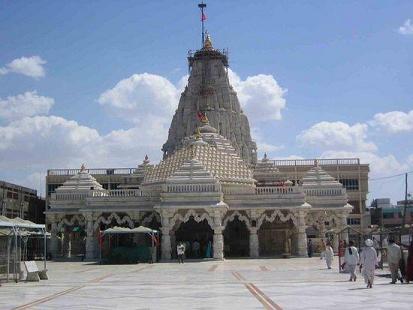
Photo: Delwara Jain Temple, Mount Abu
Interesting Facts About Dilwara Temple Mount Abu
- The Jain Dilwara temple complex is located 2.5 km from the Mount Abu town centre
- It is a major sacred pilgrimage site for Jains worldwide and is Mount Abu’s most popular attraction
- The temple complex is set in beautiful surroundings of mango trees and wooded hills – a walk around the complex is worth it
- The Dilwara temples predates the town of Mount Abu by several centuries and was built when this site was just a remote mountain area
- The complex contains five Jain temples which are known worldwide for their superb marble carvings
- Vimal Vasahi and Luna Vasahi temples are the most famous among the five Jain Dilwara temples
- It is believed that the artisans were paid according to the amount of dust they collected, encouraging them to carve ever more intricately
Information About the Dilwara Temple Complex
Set
in beautiful surroundings of mango trees and wooded hills, the Jain
Dilwara temple complex is located 2.5 km (miles) from the Mount Abu town
centre. Built by Vastupal Tejpal between the 11th and 13th centuries
AD, these temples are famous worldwide for their superb marble
carvings. This complex of five main temples is considered to be a major
sacred pilgrimage site for Jains worldwide and is Mount Abu’s most
popular attraction. The Dilwara temple complex predates the town of
Mount Abu by several centuries and was built when this site was just a
remote mountain area.
The
Dilwara temple complex is surrounded by a high white wall which dazzles
in the sunlight. The entrance way to the marble temples is opulent.
For
Jain pilgrims, there is a resthouse on the approach road with
facilities to bathe and prepare themselves, which is mandatory to
perform puja to the idols. The approach road is also lined with stalls
selling a collection of tourist kitsch lending a carnival atmosphere to
the sanctity of the temples. It would be beautiful and serene here
except for the noisy tourist guides and visitors that break the sanctity
of these magnificent temples.
Among
the beautiful Jain temples built in India, none is more spectacular or
ornate in terms of architectural perfection and beauty than the Dilwara
temples in Mount Abu. It is suggested that the artisans were paid
according to the amount of dust they collected, encouraging them to
carve ever more intricately. The intricately carved ornamental details
can be seen in the minutely carved ceilings, doorways, pillars and
panels.
Dilwara Temple complex consist of five major sections or
temples devoted to five jain trithankaras(saints):
- Shri Mahaveer Swami Temple - This temple was constructed in 1582 and is devoted to Lord Mahaveer the 24th Tirthankara of Jain's, this temple is relatively small the temple's upper walls have pictures of the porch painted by craftsmen of sirohi in year 1764.
- Shri AdiNath Temple or Vimal Vasahi Temple - This temple is build by Vimal Shah, Minister of Solanika ruler of Gujarat in 1031 A.D., this temple is the oldest of all and dedicated to Shri Adinath Ji - The first jain trithankar, the temple has an open courtyard surrounded by corridors all beautifully decorated with marble carved stones. Cells inside this temple are contain tiny images of Jain saints artistically carved on marble stone minutely. The internal dome is aesthetically decorated with design's of flowers and petals, the huge hall of the temple pillars decorated with the carving work of female figures playing musical instruments. The temple also have the "Guda Mandapa" - A simple hall decorated with the images of Shri Adi Nath.
- Shri ParshavNath Temple or Khartar Vasahi Temple - This temple was built by Mandika clan between 1458-59 A.D., this temple has the tallest shrine along with four big Mandapa's amongst all dilwara temples. The carving on the pillars of this temple is yet another example of these jain temples architectural superiority.
- Shri Rishabdaoji Temple or Peethalhar Temple - This temple is known as Pittalhari/Peethalhar temple because in this temple most of the statues are built using ‘Pittal’ (Brass Metal). This temple was built by Bhima Shah, a minister from Gujarat dynasty, like other temples of Dilwara this temple is also having Gudu Mandapa and Navchowki.
- Shri NemiNathJi Temple or Luna Vasahi Temple - This temple was built in 1230 A.D. by two brothers known as Tejpal and Vastupal, they dedicated this temple to the 22nd saint of Jainism - Shri Nemi Nathji. This temple has one hall named Rag Mandapa which has three hundred and sixty (360) tiny idols of Jain trithankar all minutely crafted on marble proving once again why these jain marble temples of Dilwara are superior to Taj Mahal, Among all these white marble idols the idol of Shri Neminath Ji is made up of black marble.The pillars of this temple were built by Maharana Kumbha of Mewar.
The Dilwara Jain Temples are open from 12 P.M. to 5 P.M. for tourist's for
free and No photography is allowed inside the temple complex.
Temple Timings (May change, pls. confirm using the phone number provided below):
Opening Time : 12:00 PM
Closing Time : 05:00 PM
Open : Daily (Even on public holidays)
Contact No : +91-2974-235151
Parshvanatha Dilwara Temple
From the entrance on the left, the first temple to be reached is Parshvanatha or Chaumukha Temple. It is dedicated to Lord Parshvanath.
Parshvanatha Dilwara temple was built by Mandlik and his family in 1458-59.
The temple is situated in a three-storied, grey sandstone building, the tallest in the Dilwara temple complex. Combining 13th- and 15th-century styles, it is generally regarded as inferior to the two main temples.
On all four faces of the sanctum on the ground floor are four big mandaps that contains four-faced images of the 23rd Jain Tirthankara, Parsvanatha (hence Chaumukha Temple). The outer walls of the sanctum comprise beautiful sculptures in gray sandstone, depicting Dikpals, double set of Vidhyadevis – one of standing figures and the other of sitting ones, a set of all 24 Yakshinis, Shalabhanjikas and other decorative sculptures especially females comparable to the ones in Khajuraho and Konark.
Vimal Vasahi Dilwara Temple
The Vimal Vasahi or Adinatha Temple lies directly ahead of Parshvanatha or Chaumukha Temple.
Vimal Visahi Dilwara temple was built in 1031 AD by Vimal Shah, the chief minister of Bhimdev I, the Chalukya King of Gujarat.
This Dilwara temple is dedicated to the first Jain Tirthankara, Adinath. It is the oldest and most famous temple in the Dilwara temple complex. Carved entirely out of white marble, it is believed to have taken 1,500 masons and 1,200 labourers 14 years to build and cost Rs 185.3 million. The white marble of which the entire temple is built was brought from the relatively nearby marble quarries of Ambaji in Gujarat, 25 km south of Abu Road.
Vimal Visahi Temple Architecture
Each and every inch of the temple’s interiors are adorned with intricate marble carvings. Makaras guard the entrance, and below them are conches. The cusped arches and ornate capitals are beautifully designed and superbly made.
Immediately outside the entrance to the temple is a small portico known as the Hastishala (elephant hall), built by Prithvipal in 1147-1159 which contains a figure of the patron, Vimal Shah, on horseback. The riders on the 10 beautifully carved elephants that surround him were removed during Alauddin Khilji’s reign. Dilwara belonged to Saivite Hindus who were unwilling to part with it until Vimal Shah could prove that it had once belonged to a Jain community. In a dream, the goddess Ambika (Ambadevi or Durga) instructed him to dig under a champak tree where he found a huge image of Adinatha and so won the land.
To the southwest, behind the hall, is a small shrine to Ambika, once the premier deity.
Similar to many other Jain temples, the plain exterior of the temple conceals a wonderful ornately carved interior which is remarkably well preserved given its age. The ceilings feature engraved designs of lotus-buds, petals, flowers and scenes from Jain and Hindu mythology. The main temple is set within a rectangular court lined with small shrines and a double colonnade, an early example of the Jain architectural style in Western India.
The temple stands in an open courtyard surrounded by a corridor. The walls of the main hall are lined with 57 shrines. Architecturally, it is suggested that these are related to the cells which surround the walls of Buddhist monasteries, but in the Jain temple the shrines are reduced in size to house simple images of a seated Jain saint. Although the carving of the images themselves is simple, the ceiling panels in front of the saints’ cells are astonishingly ornate.
Going clockwise round the cells, some of the more important ceiling sculptures illustrate: cell 1, lions, dancers and musicians; cells 2-7, people bringing offerings, birds, music-making; cell 8, Jain teacher preaching; cell 9, the major auspicious events in the life of the Tirthankars; and cell 10, Neminath’s life, including his marriage, and playing with Krishna and the gopis. In the southeast corner of the temple between cells 22 and 23 is a large black idol of Adinath, supposedly installed by Vimal Shah in 1031.
Cell 32 shows Krishna subduing Kaliya Nag, half human and half snake, and other Krishna scenes; cell 38, the 16-armed goddess Vidyadevi (goddess of knowledge); cells 46-48, 16-armed goddesses, including the goddess of smallpox, Shitala Mata; and cell 49, Narasimha, the ‘man-lion’ tearing open the stomach of the demon Hiranya-Kashyapa, surrounded by an opening lotus.
As in Gujarati Hindu temples, the main hall focuses on the sanctum which contains the 2½-m image of Adinatha or Lord Rishabdev, the first Jain Tirthankara. The sanctum is meant for worship to the deity. The sanctum with a pyramidal roof has a vestibule with entrances on three sides.
To the east of the sanctum is the mandapa (grand hall), a form of octagonal nave nearly 8 metres in diameter. Its 6-metre-wide central dome is supported by eight/twelve decorated columns and nicely carved out arches. The exquisite lotus ceiling carved from a single block of marble rises in 11 concentric circles, carved with elaborately repeated figures. On the pillars are carved female figurines playing musical instruments and superimposed across the lower rings are 16 brackets carved in the form of the goddesses of knowledge, each one holding her own symbol which is believed to be a memorial of victorious Brahma Kumaris follower from the last Kalpa.
Adhar Devi temple (Goddess Arbuda)
Devotional to Goddess Durga (Arbuda), Adhar Devi temple well-known religious tourism spot of the Mt. Abu hill, has been explored in a cave just 3 km away from the Abu town. To land on the temple, tourists have to climb up around 365 steps through the hill region and the deity has been set in a rocky cling and by creeping through a tiny hatchway alone pilgrims can enter into the cave. As it is a temple of Goddess Durga, Navaratri festival season witnesses large gathering of devotees during those nine days. Surrounded by the scenic visuals of exquisite statues, Adhar Devi shrine, finely chiseled out of a solid rock makes climbing the pleasurable chore and the tremendous visual retreat inside makes the flight of 365 stairs worthy indeed.
Nakki Lake

Photo: Nakki Lake
One more popular spot added to the travel guide amidst green Aravali range, the Nakki Lake is crowned with a fascinating attribute of love. The name Nakki explicates a romantic tale between a sage and a young woman that being precluded from tying nuptial knot symbolizing their love the bereft souls were schemed with parents of the woman and Devas who disliked the marriage. They were in demand that the sage could tie the nuptial knot if he could be digging up a lake for her using his nails all-night and the sage was just to complete this tough feat. It has been outlined that the sage being the avatar of Lord Shiva the woman was the incarnation of Goddess Parvati. Since dug by nails or nakh the name goes as Nakki and the lake henceforth is known as Nakki Lake and it is considered as sacred and worshipped by the local folks. Located at the center of Mount Abu hills where most of the restaurants have been, Nakki Lake claims the pride of the only Indian artificial watercourse above the sea level at the height of 1200 meters. The hub of evening pleasance and boating, Nakki Lake is a complete picnic spot environed with green flora of gardens, mountains, and rocky shapes of animals in addition to the beauty of sun setting canvas. Near this lovable lake, Jaipur Maharaja Palace and Raghunath Temple are other popular attractions of the hills.Toad Rock

Photo: Tod Rock
An awesome structure of Toad-shaped rock overseeing the Nakki Lake is an unimaginable posing that seems as if the toad is set ready to swim into the lake and viewing the city on top of the rock is a novel ambiance attracting the tourers for hours together basking on the rock. Nandi rock, Nun rock and Camel Rock are some of such illustrious structures retreating visual sense.
Sunset Point
Though there are numerous tourist attractions in Mount Abu, the Sunset Point holds a special significance rendering breathtaking beauty bonanza. Situated on top of the Aravali hills southwestwardly to Nakki Lake this place makes the tourists to have an inexpressive, enjoyable experience of scenic view of the sun setting. Huge gathering of people swarms this Sunset Point in the evening in the midst of a tranquil atmosphere with the temperature being considerably low offering rejuvenating experience for the vacationers after a tiresome sightseeing travel of the places. This place is structured finely with railings. From the top of the hill the sunset posing seems to be stunning and it is important not to miss watching sunset while taking a trip to Mount Abu. The environment surrounded by beautiful flowers and green trees makes this place attributed for photographic effect.

Photo: Sun set view from Sunset Point
Setting of sun can be viewed from the Guru Shikhar, the highest peak of Mount Abu as well that impresses the tourers. Other favorite spots are Honeymoon Point and Baylay's Walk that lie closer to the Sunset Point in a distance of just 5 km from Sunset Point with the pony rides making it a thoroughly pleasurable trip for thousands of tourists.
Guru Shikar Parwat (peak)
The highest mountain peak of the Aravali hills around 15 km from Mount Abu at an altitude of 1722 meters, Guru Shikar generates an enchanting panoramic view of the Abu town and green Aravali range. To atop the Guru Shikhar peak, the tourists are required to travel about 7 km along the Delwara AchalGarh road and it is a thrilling trek-like experience of course. Guru Shikhar is also a destination for marvelous historic temples. The temple of Guru Dattatreya bags a story in Hinduism that Lord Dattatreya is a deity of the divine trinity of Siva, Vishnu and Brahma and the term 'Datta' means 'given' and Dattatreya is a son of the divine trinity incarnated to a saint couple of Atri and Anasuya. As he is the son of Atri, the name suggests 'Atreya.' Outside of the Shrine is a brass, giant historic bell dated back to AD, which seems as if a sentinel is overlooking the Abu hill. The panoramic view particularly at the dawning from Guru Shikhar Parwat is a tremendous visual fete for adventure tourists.
Achalgarh Fort
AchalGarh, also pronounced as Achalgadh, historic monument found in the deserted land of Rajasthan in India is one of the numerous forts that was built by Maharana Kumbha in 15th century. The fort was primitively constructed by the rulers of Paramara Dynasty and renovated later on and named as Achalgarh by Rana Kumbha, who was passionate of designing and built many large forts in the south of Rajasthan. Well connected to the main city of Mt. Abu covering a length of around 8 km, AchalGarh fort enclosed with gigantic fortified battlement walls has been seen at the top of a sloppy, winding pathway providing picturesque view into the countryside. Beautiful Jain temples are also enclosed within the fort.

Photo: AchalGarh Fort Complex
Below down the fort, the Achleshwar temple that was built in 9th century is famous for Nandi statue made up of metals such as gold, silver, copper, brass and zinc weighing almost 4 tons. It has a myth that the temple was constructed at the spot where toe print of Lord Shiva was found. Achleshwar is of natural Shivalinga. Many sculptured idols of stones like crystal are also greatly attractive and these crystal-stoned sculptures seem to be opaque in the natural light and they look sparkled with the candles placed behind the crystal sculptures. Mandakini lake is situated that has been surrounded by rocky walls near this temple and images of Rajput kings and buffaloes are inscribed on the rocky walls.The Brahma Kumari Serene Peace Park
With the peaceful natural environs, the Brahma Kumari Serene Peace Park is a tranquil treasure for meditation and relaxation and peace lovers will enjoy the serenity and may experience complete powerful effect of meditation in this park. The park situated 8 km from Madhuban, the headquarters of Brahma Kumari Samaj in the Mount Abu is nuzzled in between the famous peaks of Aravali range. Visualizing a brief video clipping that teaches the know-how of Rajyoga the visitors could practice the Rajyoga meditation in a place of their preference, like open place, air grass hut, the stone cave, the bamboo hut or just a peaceful nook of the ambiance. The park also has attractions of recreation retreat consisting of swings, play areas, picnic spots, and walks through nature environs. Uniquely formed rock garden upon the entryway is a home for extensive categories of succulents and an orchard space displays exotic flora, including ornamental shrubs. The surrounding walls enclosing the eight-acre park are ornamented with rose creepers, oleanders and night queens for redolence and bougainvillea to add lifelike colors.
Shantivan, the Brahma Kumari meditation center located on the left side of the Abu Road is a place of picturesque framing. A spacious hall accommodating around 20,000 people known to be Diamond Hall is a zest for wonderful architecture and marvelous piece of art. Another important tourist attraction is Madhuban, international religious community of Brahma Kumari and Madhuban is the headquarters of the Brahma Kumaris World Spiritual University or globally known as Prajapita BrahmaKumaris Ishwariya Vishwa Vidyalaya, which is located near the Nakki Lake.
Museum and Art Gallery
Domiciliated within the campus of Raj Bhawan, the government museum and art gallery in Mount Abu that was constituted in the year 1962 takes the pride of preserving the archeological monuments of the hill region. Categorized into two sections, first section of the museum comprises of panoramic illustration of local tribal hut with the lifestyle of the tribes including a art gallery of arms and artilleries, musical instruments, furniture, handicrafts, ornaments such as barly, damani, karna, guthma toda, gaga wala thoomar, kanksi berla, different kinds of earrings and costumes, etc. The second section consists of a collection of theme-based paintings on raga-ragnis, lain images from Sirohi, midsize shields, canon called 'Topdi' and pieces of wood carvings. A noteworthy piece of monument amidst the collections of the art gallery is exquisite carving of the statues of Devdasi (Nartaki or dancer) from 6-12th century A.D. that were obtained from the ancient Chandravati town situated 7 kms away from Abu. The image of the Chakrabahu Shiva seated on Nandi, Lord Shiva's bull, holding a trishul and khadag in the hands and dancing girls on both sides of Shiva is indeed marvelous. Around 404 sculptures of Abu collections are also added to the museum, out of which the most unique display is a 3-feet Vish Kanya (Snake Goddess) exhibited as if it is breast-feeding a snake with well-executed features and naturalistic impressive postures. Other important pieces of exhibition are Surya from 8th century A.D. of Achalgarh, the Shiva of 10th century contributed by Dilwara temple, the Chanvar Vahini and Laxmi of 12th century from Chandravati and the Chanmunda of 8th century A. D.
Trevor's Crocodile Park
Set up by an engineer from British, named Trevor, this is a nature lovers' paradise. The artificial tank built by the above named professional known as Trevor's Tank is a home to breed crocodiles of multiple varieties in the natural habitat. For bird watchers also, this is a sanctuary in the thick woods of the Abu hills that houses peacocks, partridges and pigeons with natural environment.
Wildlife sanctuary for trekking and adventure tourism
Sanctuary in Mount Abu is an excellent wildlife sanctuary with ravishing landscape that offers great experience for nature lovers to explore the nature completely, consisting of more than 17 nature trails or pathways through the woods as shown on the map. Added to these trails, the jungle region includes view points, grasslands, water bodies, horse safari, and sunrise/sunset points. With the trekking, trekkers may have adventurous tourism of rock climbing, rappling, wildlife viewing, bird watching and study about botanical treasure of Abu, its tribal lifestyle and culture of Lok Rajput as well. With prior permission obtained from the State Department of Forests, the sanctuary has various locations for camping in the jungle. The list of locations in which camping has been permitted is as follows:
1. Trevor's tank Dilwara
2. Gaumukh Hanumanji
3. Arna watch tower
4. Salgaon watch tower
5. Jawai village
6. Agneshwar Ashram
7. Rishikesh Temple
8. Chhipa Beri
9. Kuda- mamaji
10. Vasthanji
11. Utraj village
12. Bhrigu Ashram
Major nature trails of the sanctuary are as mentioned below:
1. Tiger Path
2. Craig's Path
3. Beyley's walk
4. Sunset Point - Sakora
5. Trevor's Tank
6. Guru shikhar
7. Dilwara - Salgaon
8. Arna - Chhipaberi
9. Gaumukh - Bagheri
10. Gaumukh - Chandel
11. Sirohi Kothi
12. Honeymoon Point
13. Achalgarh
14. Utraj - Vasthanji Trail
15. Mini Nakki - Anjani Mata
16. Bridal Path
For trekking, horse safari, camping, ecotourism or adventure tourism, well-trained nature guides are available in Mount Abu.
Contact information for trekking and camping:
Deputy Conservator of Forest (Wildlife)
Sunset Road Mount Abu, Sirohi District, Rajasthan.-307501
Phone: 02974-43211 (O)
Fax: 02974-38900
After finishing 5 days and 6 nights journey to South Rajasthan, we went back to our destination Vadodara By trai n from Abu road.
